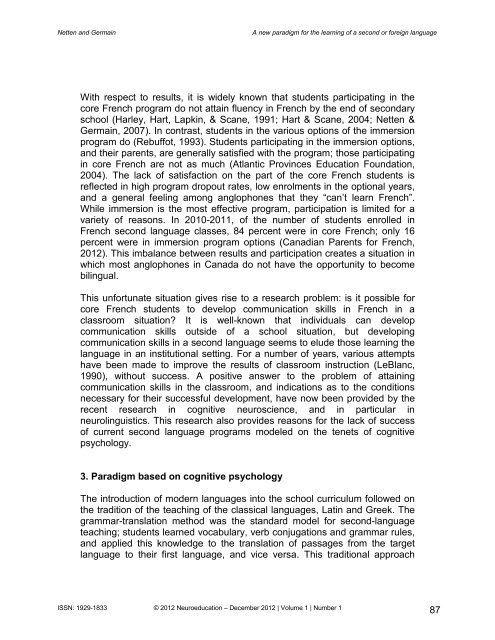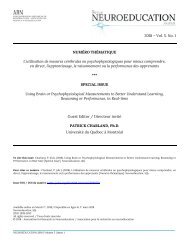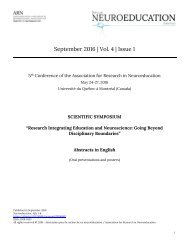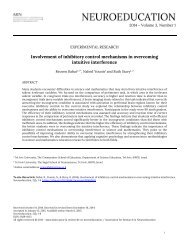Neuroeducation_2012_vol-1_no-1_full
Neuroeducation journal - Volume 1, Issue 1 (2012) - 144 pages
Neuroeducation journal - Volume 1, Issue 1 (2012) - 144 pages
You also want an ePaper? Increase the reach of your titles
YUMPU automatically turns print PDFs into web optimized ePapers that Google loves.
Netten and Germain<br />
A new paradigm for the learning of a second or foreign language<br />
With respect to results, it is widely k<strong>no</strong>wn that students participating in the<br />
core French program do <strong>no</strong>t attain fluency in French by the end of secondary<br />
school (Harley, Hart, Lapkin, & Scane, 1991; Hart & Scane, 2004; Netten &<br />
Germain, 2007). In contrast, students in the various options of the immersion<br />
program do (Rebuffot, 1993). Students participating in the immersion options,<br />
and their parents, are generally satisfied with the program; those participating<br />
in core French are <strong>no</strong>t as much (Atlantic Provinces Education Foundation,<br />
2004). The lack of satisfaction on the part of the core French students is<br />
reflected in high program dropout rates, low enrolments in the optional years,<br />
and a general feeling among anglophones that they “can’t learn French”.<br />
While immersion is the most effective program, participation is limited for a<br />
variety of reasons. In 2010-2011, of the number of students enrolled in<br />
French second language classes, 84 percent were in core French; only 16<br />
percent were in immersion program options (Canadian Parents for French,<br />
<strong>2012</strong>). This imbalance between results and participation creates a situation in<br />
which most anglophones in Canada do <strong>no</strong>t have the opportunity to become<br />
bilingual.<br />
This unfortunate situation gives rise to a research problem: is it possible for<br />
core French students to develop communication skills in French in a<br />
classroom situation? It is well-k<strong>no</strong>wn that individuals can develop<br />
communication skills outside of a school situation, but developing<br />
communication skills in a second language seems to elude those learning the<br />
language in an institutional setting. For a number of years, various attempts<br />
have been made to improve the results of classroom instruction (LeBlanc,<br />
1990), without success. A positive answer to the problem of attaining<br />
communication skills in the classroom, and indications as to the conditions<br />
necessary for their successful development, have <strong>no</strong>w been provided by the<br />
recent research in cognitive neuroscience, and in particular in<br />
neurolinguistics. This research also provides reasons for the lack of success<br />
of current second language programs modeled on the tenets of cognitive<br />
psychology.<br />
3. Paradigm based on cognitive psychology<br />
The introduction of modern languages into the school curriculum followed on<br />
the tradition of the teaching of the classical languages, Latin and Greek. The<br />
grammar-translation method was the standard model for second-language<br />
teaching; students learned vocabulary, verb conjugations and grammar rules,<br />
and applied this k<strong>no</strong>wledge to the translation of passages from the target<br />
language to their first language, and vice versa. This traditional approach<br />
ISSN: 1929-1833 © <strong>2012</strong> <strong>Neuroeducation</strong> – December <strong>2012</strong> | Volume 1 | Number 1<br />
87








